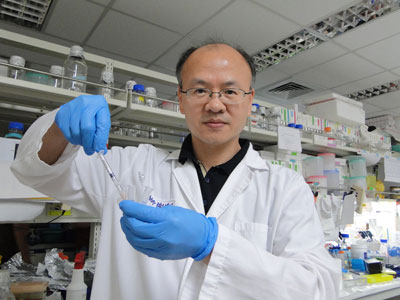 A National Cheng Kung University (NCKU) research team has made a breakthrough in the regeneration of new blood vessels in cardiovascular therapy by using nanofibers and vascular endothelial growth factor (VEGF).
A National Cheng Kung University (NCKU) research team has made a breakthrough in the regeneration of new blood vessels in cardiovascular therapy by using nanofibers and vascular endothelial growth factor (VEGF).
Aug 10th, 2012
Read more
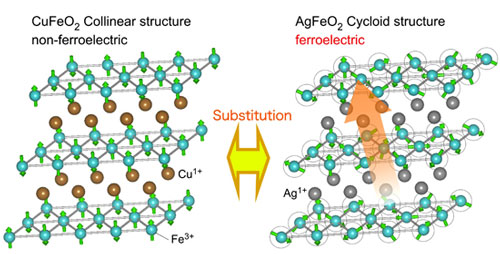 Researchers have discovered that magnetic and dielectric properties can be largely controlled by substituting other atoms for the nonmagnetic atoms in a magnetic material.
Researchers have discovered that magnetic and dielectric properties can be largely controlled by substituting other atoms for the nonmagnetic atoms in a magnetic material.
Aug 10th, 2012
Read more
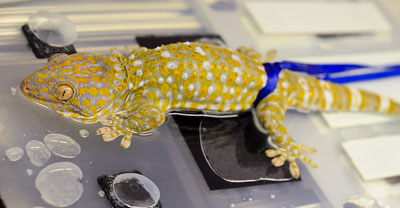 Scientists already know that the tiny hairs on geckos' toe pads enable them to cling, like Velcro, to vertical surfaces. Now, University of Akron researchers are unfolding clues to the reptiles' gripping power in wet conditions in order to create a synthetic adhesive that sticks when moist or on wet surfaces.
Scientists already know that the tiny hairs on geckos' toe pads enable them to cling, like Velcro, to vertical surfaces. Now, University of Akron researchers are unfolding clues to the reptiles' gripping power in wet conditions in order to create a synthetic adhesive that sticks when moist or on wet surfaces.
Aug 10th, 2012
Read more
The newspaper-style printing of electronic equipment has led to a cost-effective device that could change the way we interact with everyday objects.
Aug 10th, 2012
Read more
The intricate properties of the fingertips have been mimicked and recreated using semiconductor devices in what researchers hope will lead to the development of advanced surgical gloves.
Aug 10th, 2012
Read more
Researchers from the University of Pennsylvania, along with collaborators from Italy and Spain, have created a material that catalyzes the burning of methane 30 times better than do currently available catalysts.
Aug 9th, 2012
Read more
Geckos are remarkable little creatures, clinging to almost any dry surface, and Alyssa Stark, from the University of Akron, USA, explains that they appear to be equally happy scampering through tropical rainforest canopies as they are in urban settings.
Aug 9th, 2012
Read more
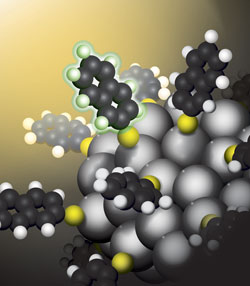 Center for Nanoscale Materials (CNM) users from the Ecole Polytechnique Federale de Lausanne in Switzerland, working with the CNM Nanophotonics Group, have demonstrated the existence of long-lived charge-separated states in silver clusters.
Center for Nanoscale Materials (CNM) users from the Ecole Polytechnique Federale de Lausanne in Switzerland, working with the CNM Nanophotonics Group, have demonstrated the existence of long-lived charge-separated states in silver clusters.
Aug 9th, 2012
Read more
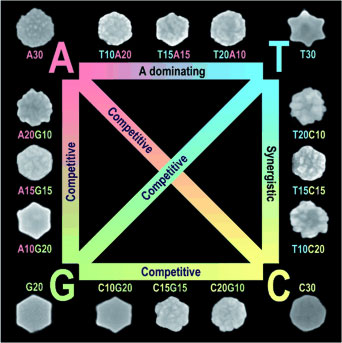 Different sequences of DNA influence morphology of growing gold nanocrystals.
Different sequences of DNA influence morphology of growing gold nanocrystals.
Aug 9th, 2012
Read more
Thirty-eight undergraduate students who have spent the summer doing nanotechnology research at the College of Nanoscale Science and Engineering of the University at Albany showcased their findings August 8 at a public poster presentation that is the capstone of CNSE's 2012 Summer Internship Program.
Aug 8th, 2012
Read more
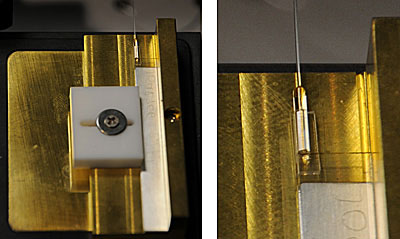 Tests show that a new method for splitting photon beams could overcome a fundamental physical hurdle in transmitting electronic data. These results could lead to commercial systems that can help safeguard the transfer of sensitive information.
Tests show that a new method for splitting photon beams could overcome a fundamental physical hurdle in transmitting electronic data. These results could lead to commercial systems that can help safeguard the transfer of sensitive information.
Aug 8th, 2012
Read more
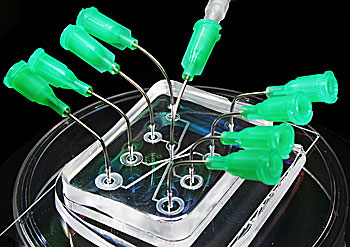 Lab on a chip (LOC) devices - microchip-size systems that can prepare and analyze tiny fluid samples with volumes ranging from a few microliters to sub-nanoliters - are envisioned to one day revolutionize how laboratory tasks such as diagnosing diseases and investigating forensic evidence are performed. However, a recent paper from the National Institute of Standards and Technology argues that before LOC technology can be fully commercialized, testing standards need to be developed and implemented.
Lab on a chip (LOC) devices - microchip-size systems that can prepare and analyze tiny fluid samples with volumes ranging from a few microliters to sub-nanoliters - are envisioned to one day revolutionize how laboratory tasks such as diagnosing diseases and investigating forensic evidence are performed. However, a recent paper from the National Institute of Standards and Technology argues that before LOC technology can be fully commercialized, testing standards need to be developed and implemented.
Aug 8th, 2012
Read more
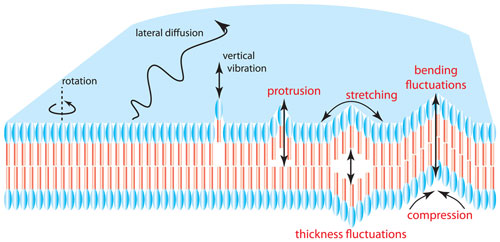 A long-standing mystery in cell biology may be closer to a solution thanks to measurements taken at the National Institute of Standards and Technology and France's Institut Laue-Langevin, where scientists have observed changes in the thickness of a model cell membrane for the first time. The findings, which confirm that long-predicted fluctuations occur in the membranes, may help biologists understand many basic cellular functions, including how membranes form pores.
A long-standing mystery in cell biology may be closer to a solution thanks to measurements taken at the National Institute of Standards and Technology and France's Institut Laue-Langevin, where scientists have observed changes in the thickness of a model cell membrane for the first time. The findings, which confirm that long-predicted fluctuations occur in the membranes, may help biologists understand many basic cellular functions, including how membranes form pores.
Aug 8th, 2012
Read more
Physicists at the National Institute of Standards and Technology can accelerate their beryllium ions from zero to 100 miles per hour and stop them in just a few microseconds. What's more, the ions come to a complete stop and hardly feel the effects of the ride. And they're not just good for submicroscopic racing - NIST physicists think their zippy ions may be useful in future quantum computers.
Aug 8th, 2012
Read more
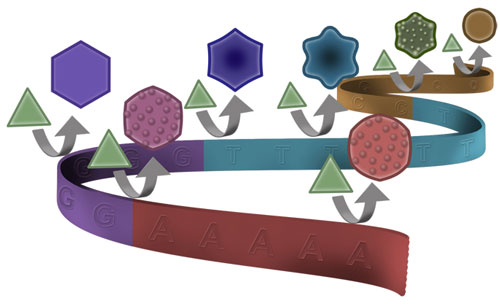 DNA holds the genetic code for all sorts of biological molecules and traits. But University of Illinois researchers have found that DNA's code can similarly shape metallic structures. The team found that DNA segments can direct the shape of gold nanoparticles - tiny gold crystals that have many applications in medicine, electronics and catalysis.
DNA holds the genetic code for all sorts of biological molecules and traits. But University of Illinois researchers have found that DNA's code can similarly shape metallic structures. The team found that DNA segments can direct the shape of gold nanoparticles - tiny gold crystals that have many applications in medicine, electronics and catalysis.
Aug 8th, 2012
Read more
 Each summer, Johns Hopkins Institute for NanoBioTechnology has funding to support several summer research internships abroad. The International Research Experience for Students program, funded by the National Science Foundation, provides support for students to work with researchers at The Inter-University MircroElectronics Centre (IMEC) in Leuven, Belgium. Students work at IMEC's world-class microfabrication facility and learn to design, fabricate and test a wide range of biomedical devices.
Each summer, Johns Hopkins Institute for NanoBioTechnology has funding to support several summer research internships abroad. The International Research Experience for Students program, funded by the National Science Foundation, provides support for students to work with researchers at The Inter-University MircroElectronics Centre (IMEC) in Leuven, Belgium. Students work at IMEC's world-class microfabrication facility and learn to design, fabricate and test a wide range of biomedical devices.
Aug 8th, 2012
Read more
 A National Cheng Kung University (NCKU) research team has made a breakthrough in the regeneration of new blood vessels in cardiovascular therapy by using nanofibers and vascular endothelial growth factor (VEGF).
A National Cheng Kung University (NCKU) research team has made a breakthrough in the regeneration of new blood vessels in cardiovascular therapy by using nanofibers and vascular endothelial growth factor (VEGF).









 Subscribe to our Nanotechnology News feed
Subscribe to our Nanotechnology News feed